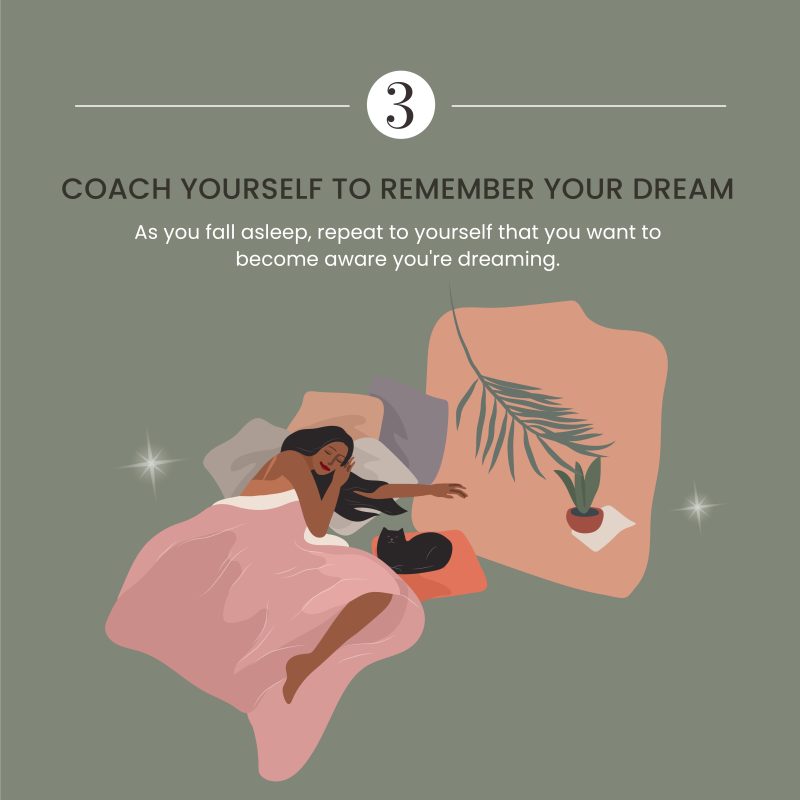Most of us feel like passive participants in the dream world. It seems as if our mind is guiding us along, playing out our hidden—or not-so-hidden—desires, as Sigmund Freud theorized, or expressing a deep meaning that only our unconscious mind knows, as Carl Jung believed. [1]
Imagine, instead, controlling what happens. Picture yourself guiding the direction of your dream and engaging and manipulating your surroundings. That’s lucid dreaming. It’s a powerful phenomenon that studies have shown can eliminate nightmares, help with insomnia, and improve your creativity. [2, 3, 4, 5]
What is lucid dreaming?
Lucid dreaming is when you become aware you’re dreaming but remain asleep. [12] You’re conscious of being in a dream. You can interact with your surroundings, changing your dream’s narrative and controlling your own behavior.
It’s being in a state of “perfect awareness [and the dreamer] is able to direct [their] attention, and to attempt different acts of free volition,” said Dutch psychiatrist Frederik Van Eeden in his own personal account of the dream phenomenon and the first to refer to coin the term. [6]
Lucid dreaming is when you become aware you’re dreaming but remain asleep. You’re conscious of being in a dream. You can interact with your surroundings, changing your dream’s narrative and controlling your own behavior.
When do lucid dreams happen?
Lucid dreams typically happen during the REM (rapid eye movement) stage of sleep. [1, 2] This stage occurs about 90 minutes after you first fall asleep, with the first level only lasting about 10 minutes and each progressive stage lasting longer and longer. [7]
This is the time during the night when you’re most likely to dream because your brain is most active. However, a 2019 study published in Neuroscience and Biobehavioral Reviews suggests having a lucid dream during non-REM sleep cycles is possible, although it’s less likely. [6]
How do you know you’re lucid dreaming?
Machiel Klerk, psychotherapist and author of Dream Guidance, says there are levels of becoming aware of your dream.
It may begin with “a slight sense of this is strange, as I am talking to grandma, however, grandma is dead. You think it is weird, and there is some slight sense of, this might be a dream, and then the dream continues.”
Then, there’s complete lucidity when “you are completely aware that you are in the dream world and can make decisions and engage proactively with the dream environment.”
What are the benefits of lucid dreams?
There are numerous benefits you can expect from lucid dreaming. Some of the top benefits include:
Lucid dreaming can help with nightmares
By controlling your dream, you can manipulate the negative surroundings associated with a nightmare. A 2022 study published in Sleep Advances: A Journal of the Sleep Research Society confirmed this, showing that many participants found that becoming lucid in a dream allowed them to remove themselves from a bad dream and even overcome recurring ones. [8]
Lucid dreams can improve your motor skills
A lucid dream allows you to improve your skills. In a 2015 study published in the Journal of Sports Sciences, participants received an initial motor skill assessment, and after practicing during a lucid dream, they showed significant improvement. [9]
Lucid dreaming can reduce symptoms of PTSD
A 2023 study published in Traumatology invited 49 adults who reported signs of PTSD to a lucid dreaming healing workshop. Of those who were able to practice lucid dreaming, they showed improvements in mental well-being, PTSD symptom scores, and nightmare distress. [10]
Lucid dreaming can help with insomnia
If you struggle with insomnia, you’ll be pleased to learn that knowing how to lucid dream might help. A 2020 study published in Behavioral Sleep Medicine revealed that people who could lucid dream found a significant reduction in their insomnia symptoms. [3]
What are the drawbacks of lucid dreams?
Despite the countless benefits of being able to lucid dream, there are some drawbacks:
You may have a negative dream experience
Not everyone who can have a lucid dream has had a positive experience. The 2022 study published in Sleep Advances: A Journal of the Sleep Research Society noted that some lucid dreamers reported obtaining an awareness of being in a dream, as is expected when becoming lucid, but were unable to gain control, or they appeared to make matters worse. [8]
Your sleep may be affected
Within the study, as mentioned above, those who experienced negative dreams often had interrupted sleep, especially if the dreams were too intense. [8, 12]
Your mental health may be affected
Although several studies have shown that lucid dreaming can positively impact your mental health, others have shown it can potentially be harmful to those who deal with psychosis. [11, 12] While more research needs to be done, it’s essential to consider the risk.




How to have a lucid dream
If you want a lucid dream, you can incorporate a few routines during your day and before you sleep. However, if you struggle with psychosis, please take precautions and discuss the possibilities of lucid dreaming with your psychologist or doctor before attempting to try it.
Perform reality checks during the day
One trick to triggering a lucid dream is developing awareness of when you’re in a dream or awake state. Start checking during your day, such as whether you can put your thumb through your hand or note whether your surroundings look different or unusual. [13]
Keep a dream journal
Improving dream recall can increase your chance of having lucid dreams. Write any dreams you remember upon waking up, including any details you can recall. [13]
Coach yourself to remember your dream
As you fall asleep, repeat to yourself that you want to become aware that you’re dreaming. Klerk suggests that you can also say, “Tonight in my dream, I will see my hands, and when I see my hands, I will notice that I am dreaming.”
FAQs
What causes lucid dreams to happen?
Although science doesn’t know exactly what triggers a lucid dream, research suggests they happen because of activity in the brain’s prefrontal cortex and temporoparietal association areas. Those are areas of the brain where emotions, thoughts, and actions reside. They’re dormant while asleep unless you have a lucid dream, which can activate those areas. [14]
What happens when you enter a lucid dream?
Once you become conscious you’re dreaming, you’ve begun lucid dreaming. This level of consciousness allows you to control the direction of the dream and interact with your surroundings. You typically have greater awareness of the dream, which can help you overcome nightmares by changing their narrative.
Is a lucid dream good or bad?
A lucid dream can be a positive experience. You may find you can redirect bad dreams. You can also gain a greater sense of enjoyment from dreaming because you can control your surroundings and guide the dream’s direction. However, any downsides can come about because you can’t manipulate the dream but still have awareness or if you have psychosis issues.
Next, learn all about the reasons why dreaming is good for your health.
References
- Brescia University. The Psychology of Dreams: Inside the Dream Mind. https://www.brescia.edu/2016/09/psychology-of-dreams/
- NIGHTMARESDe Macêdo, T. C., Ferreira, G. H., De Almondes, K. M., Kirov, R., & Arthuro, S. (2019). My Dream, My Rules: Can Lucid Dreaming Treat Nightmares? Frontiers in Psychology, 10, 486800. https://doi.org/10.3389/fpsyg.2019.02618
- INSOMNIAEllis, J. G., De Koninck, J., & Bastien, C. H. (2021). Managing Insomnia Using Lucid Dreaming Training: A Pilot Study. Behavioral sleep medicine, 19(2), 273–283. https://doi.org/10.1080/15402002.2020.1739688
- INSOMNIAVoss, U., Holzmann, R., Tuin, I., & Hobson, J. A. (2009). Lucid Dreaming: A State of Consciousness with Features of Both Waking and Non-Lucid Dreaming. Sleep, 32(9), 1191-1200. https://doi.org/10.1093/sleep/32.9.1191
- CREATIVE Zink, N., & Pietrowsky, R. (2013). Relationship between lucid dreaming, creativity and dream characteristics. International Journal of Dream Research, 6(2), 98–103. https://psycnet.apa.org/record/2014-01847-005
- Van Eeden, Frederik. A Study of Dreams. Proceedings of the Society for Psychical Research, Vol. 26. (1913). https://dreamscience.ca/en/documents/New%20content/lucid%20dreaming%20pdfs/vanEeden_PSPR_26_1-12_1913.pdf
- Cleveland Clinic. Sleep. https://my.clevelandclinic.org/health/body/12148-sleep-basics
- Mallett, R., Sowin, L., Raider, R., Konkoly, K. R., & Paller, K. A. (2022). Benefits and concerns of seeking and experiencing lucid dreams: Benefits are tied to successful induction and dream control. Sleep Advances: A Journal of the Sleep Research Society, 3(1). https://doi.org/10.1093/sleepadvances/zpac027
- Stumbrys, T., Erlacher, D., & Schredl, M. (2016). Effectiveness of motor practice in lucid dreams: a comparison with physical and mental practice. Journal of Sports Sciences, 34(1), 27–34. https://doi.org/10.1080/02640414.2015.1030342
- Yount, G., Stumbrys, T., Koos, K., Hamilton, D., & Wahbeh, H. (2023). Decreased posttraumatic stress disorder symptoms following a lucid dream healing workshop. Traumatology. https://doi.org/10.1037/trm0000456
- Mota, N. B., Resende, A., Mota-Rolim, S. A., Copelli, M., & Ribeiro, S. (2016). Psychosis and the Control of Lucid Dreaming. Frontiers in Psychology, 7, 294. https://doi.org/10.3389/fpsyg.2016.00294
- Soffer-Dudek, N. (2019). Are Lucid Dreams Good for Us? Are We Asking the Right Question? A Call for Caution in Lucid Dream Research. Frontiers in Neuroscience, 13. https://doi.org/10.3389/fnins.2019.01423
- Adventure-Heart, Denholm & Delfabbro, Paul & Proeve, Michael & Mohr, Philip. (2017). Reality Testing and the Mnemonic Induction of Lucid Dreams: Findings From the National Australian Lucid Dream Induction Study. Dreaming. 27. 206-231. https://www.researchgate.net/publication/319855294.
- Baird, B., Castelnovo, A., Gosseries, O., & Tononi, G. (2018). Frequent lucid dreaming associated with increased functional connectivity between frontopolar cortex and temporoparietal association areas. Scientific Reports, 8. https://doi.org/10.1038/s41598-018-36190-w




